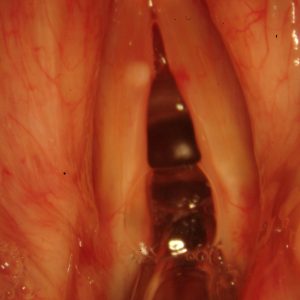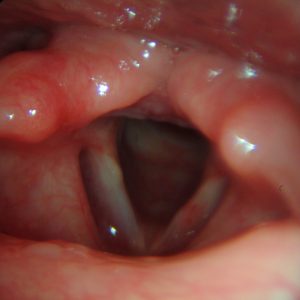GPA is a rare autoimmune disease that causes inflammation in small blood vessels throughout the body, especially in the lungs, kidneys, sinuses, and airway. When it affects the voice box (larynx), it usually causes subglottic stenosis, or narrowing just below the vocal cords. This can lead to hoarseness, noisy breathing (stridor), shortness of breath, or frequent throat infections. Symptoms can build slowly, and it may first look like stubborn laryngitis. Because GPA is a systemic disease, it’s usually treated with oral steroids, immune-suppressing pills, and sometimes biologic drugs (prescribed by a rheumatologist). In our office, we can help manage the laryngeal symptoms with in-office steroid injections and airway dilations to open the narrowed area. In more advanced cases, a surgical airway procedure may be needed, though we try to avoid that with early intervention.
Sarcoidosis is an autoimmune disease that causes inflammatory nodules (granulomas) to form in multiple parts of the body, especially the lungs, lymph nodes, and skin. It can also affect the larynx, leading to symptoms like hoarseness, breathing difficulty, a muffled voice, and swelling in the throat. The changes can be gradual and are sometimes mistaken for allergies or reflux. In early stages, oral or inhaled steroids are often effective. When sarcoidosis causes swelling or narrowing in the larynx, we can help manage it with in-office steroid injections, and in some cases, CO2 laser treatment or dilation procedures to open the airway. We work closely with other specialists if the disease affects other organs.
Rheumatoid nodules are firm bumps that develop on the vocal cords in people with rheumatoid arthritis or other autoimmune diseases like lupus. These diseases affect the joints, but can also cause vocal fold inflammation. These nodules usually grow slowly and can cause hoarseness, vocal fatigue, or voice breaks that come and go. Treatment starts with managing the underlying disease through oral medications prescribed by a rheumatologist. In our office, we evaluate the nodule with rigid laryngoscopy and stroboscopy. If needed, we may perform an in-office steroid injection or proceed with surgical removal under general anesthesia if the nodule is large or the nodules stiffens the vocal cord.

Rheumatoid Nodule

Rheumatoid Nodule
Pemphigus is a rare autoimmune blistering disease that typically starts in the skin or mouth but can also affect the throat and voice box. When it involves the larynx, it can cause painful sores, hoarseness, coughing, throat bleeding, and even scar tissue that narrows the airway. Related diseases include pemphigoid and cicatricial pemphigoid, which can also cause mucosal scarring in the throat. Pemphigus is usually managed with oral or intravenous steroids, and immune-suppressing medications coordinated with a dermatologist or rheumatologist. In our office, we help manage airway symptoms with CO2 laser treatment, injections, or dilation to open any scarred areas. If airway narrowing becomes severe, we may recommend surgery or, in rare cases, a tracheostomy.
While Crohn’s disease and ulcerative colitis primarily affect the digestive tract, they can occasionally cause inflammation in the throat or larynx. Patients may notice sore throat, hoarseness, or a burning sensation in the throat during a digestive flare-up. These cases are uncommon and usually resolve once the bowel disease is under control. We can evaluate the larynx to rule out other causes of inflammation. If needed, we may prescribe a short course of oral or inhaled steroids, but usually, no procedures or surgeries are required.
Aphthous ulcers are small, shallow sores that can develop in the mouth or throat, including the larynx. They are not part of a systemic disease and usually appear during times of stress, illness, or immune suppression. They can cause mild pain, irritation, and frequent throat clearing, but they don’t block the airway. Treatment is simple and supportive. In our office, we may recommend saltwater gargles, topical treatments, or expectorants to soothe the area. These ulcers usually go away on their own within 1–2 weeks, and no surgery or procedure is needed.

 YouTube Channel
YouTube Channel
